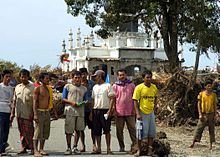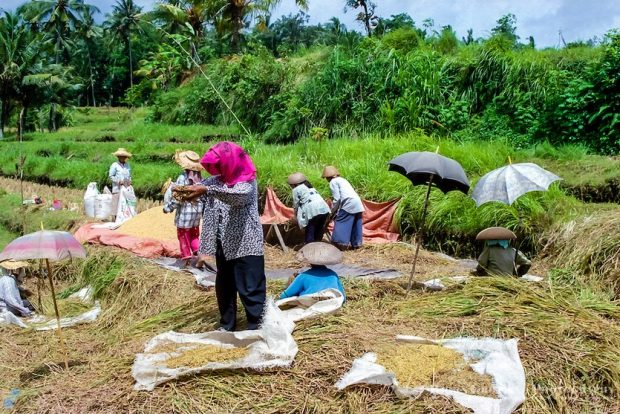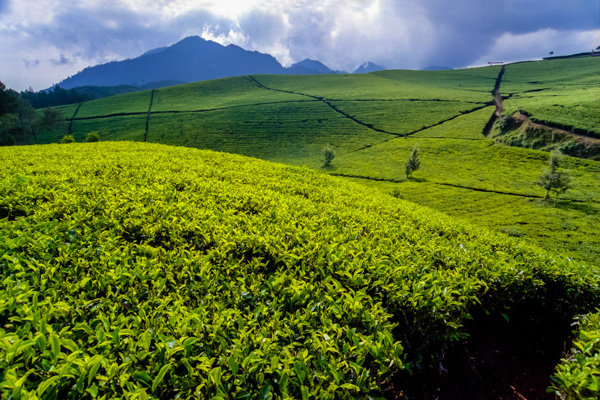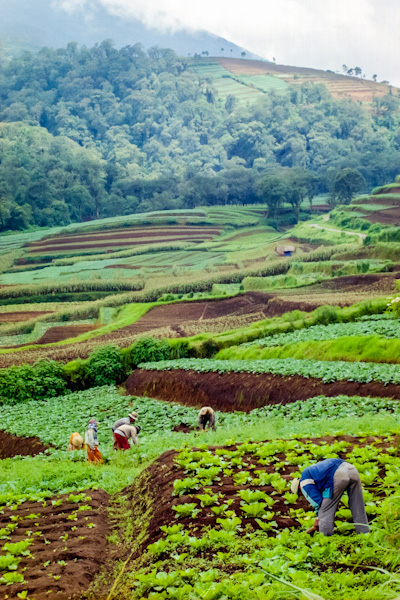Sumatra is the fifth largest island in the world and the third largest in Indonesia. Population is about 40 million. The island is divided in the Aceh, Riau, Jambi, Bengkulu and Lampung provinces, and North, South and West Sumatra. It borders the Indian Ocean to the west and Malaysia to the east, separated from the Malay peninsula by the Malacca strait. Area is about 425.000 square kilometers.

A volcanic chain of mountains, Bukit Barisan, stretches from the south to the northwest part of the island.There are not much lowland along the west coast so most of the people here live in the highlands. Highest mountain on the island is Gunung Kerinci with 3.805 m. There is about 90 volcanoes on Sumatra, of which 15 are still active. The volcanic ash here is mostly acid, and does not help to improve the farmland, unlike on Java and Bali. There are a few exceptions, like the area around Bukittinggi where the soil is very fertile.

East part of Sumatra is clearly different from the west with a huge plain from south to north. Half of this is mostly swamps, and not very suitable for agriculture. An exception is the area around Medan, which today is the most densely populated area on Sumatra. Close to Medan is the huge Toba crater lake, a big tourist attraction. The islands outside the west coast, like Nias and Mentawai, are geologically older than the Sumatra mainland.
Sumatra climate:
The equator line go across the center of the island, and the climate here is tropical. Average temperature is about 25 to 27 degrees Celsius, along the coast the day temperature almost never drops below 30 degrees. Fortunately for the traveler most of the attractions are located in the highlands, where the nights can be rather cool. The best time to visit Sumatra is during the dry season between May and September. Time of the wet season can vary a lot, usually with January as the wettest month.
Flora and fauna:

Large parts of the island are still covered by rain forest, and the wildlife is rich and diverse. Some of the animals living here are elephant, orangutan, tiger, tapir and leopard. Unfortunately some species are highly endangered, much due to loss of habitat caused by the increased deforesting. Large areas are now made into national parks and reserves, and programs like rehabilitation of illegally captured orangutan’s give some results. The most popular parks are Gunung Leuser to the north and Kerinci Seblat south of Padang.
Sumatra is home to the worlds largest (and smelliest) flower; the Rafflesia. This only blooms about every 20 years and is said to smell like rotten flesh. Sumatra is one of a few places this can be found in the nature, it grows in small pockets all over the Barisan mountains, for example close to Bukittinggi.
People and Religion:

Sumatra have a population of about 40 million. Islam first came here and to the rest of South East Asia late in the 13th century, at first to the north east coast were one of the first cities that converted to Islam was Samudra
. This name was later given to the entire island, Samudra means “ocean” in Sanskrit. This part of Sumatra was from the 16th century called the Sultanate of Aceh, an area today known for it’s strong independence movement and maybe the region in Indonesia were Islam has the strongest position.
Much of Sumatra’s population today descends from Malay people, the largest ethnic groups are Acehnese, Batak, Minangkabau, Gayo and some other, smaller indigenous groups. In the big cities there are also large groups of Chinese, Arabs and Indians.
Economy:
The large rivers flowing on east Sumatra are very important for interior transport of goods and people. Important goods produced on Sumatra are rice, maize, tea, coffee, coconuts, spices, timber, oil and bauxite. The Dutch first found oil here in 1883, which led to the founding of the Royal Dutch Shell Company, today one of the largest oil companies in the world. The island is today producing about three quarters of Indonesia’s crude oil, with refineries that produce gasoline and plastic. Sumatra is called the backbone of Indonesia because of its large natural resources.
History:
It is not much we know about Sumatra before the arrival of Islam. Stone tools found north of Medan indicates that hunter-gatherers lived along the strait of Malacca 13.000 years ago, and about 2.000 years ago a megalithic culture appeared in the mountains of western Sumatra, about the same time as a megalithic culture appeared on the Nias island outside the western coast.

Sumatra had little contact with the outer world before a large trade empire appeared on the southeast coast of the island in the 7th century, probably with the main base in today’s Palembang. This was the Buddhist kingdom of Srivijaya, which controlled all traffic through the Malacca strait and the Sunda strait between Java and Sumatra. Eventually Srivijaya controlled large parts of South East Asia, at it’s peak it ruled the whole of Sumatra, the Malay peninsula, South Thailand, Cambodia and large parts of Java and Borneo. The empire started to collapse when it was conquered by the South India king Ravendra Choladewa in 1025.
The Malayu kingdom took over some of Srivijaya’s power and glory for the next 200 years. Malayu was in 1278 defeated by a Japanese expedition, and the power center moved north to a group of Islamic sultanates on the east coast of what is now called Aceh. The sultanates were originally ports for the increasing trade through the Strait of Malacca, and a large number of the traders were Muslims from West India. The traders eventually convinced some of the native people to adopt their own religion, and Islam first got it’s foothold in Indonesia.
Marco Polo spent five months in the Samudra harbor in 1292. In his report he used the name Sumatra, maybe it was this error that gave the island it’s present name. After the Portuguese conquered Malacca on the Malaysian peninsula in 1512 Aceh took control over North Sumatra, in addition they controlled large parts of the Malaysian peninsula. Aceh kept this control until the 17th century.
Colonization:
The Portuguese established trade stations on Sumatra as early as 1509 while the Dutch first came to the island in the 17th century. The Dutch built a base in Padang on the west coast, but did not make any serious military attempts before they were driven away during the Napoleon wars. On return they soon discovered that their own influence here was totally gone. The British had established themselves in Bencoolen (Bengkulu) and on the Penang island. Other nations were established on Sumatra as well and traded with the island’s natural resources.

The Dutch campaign to control Sumatra started with a failed attack on Palembang in 1818, a new attempt in 1825 was more successful, but the fightings continued in the interior of South Sumatra until 1847. On West Sumatra the Dutch influence was challenged by the Islamic “Padri” movement which was determined to establish an Islamic society. War broke out between Padri and the followers of the traditional Minangkabau adat in 1803, the Dutch entered the war on the traditional leaders side in 1821 when the Padri’s controlled much of the highlands. The Benteng de Kock fort in Bukittinggi became the new main base for the Dutch and in 1837 they finally conquered Bonjol, the headquarters of the Padri leader Imam Bonjol. After three attempts they also conquered the Nias island in 1863.
The rivalry between the British and the Dutch continued until 1824, when a peace treaty was signed. The British gave up Sumatra in exchange for Malacca, which included large parts of the Malaysian peninsula (see Riau). The war against the Bataks ended in 1872, even if the Batak resistance lasted until 1895. The last area to be occupied by the Dutch was Aceh, but not without tough resistance and large losses for the Dutch. The Acehnese forced the intruders back in 1873, however two years later they had to admit defeat. Several of the Aceh soldiers escaped into the jungle and started a guerilla war which ended in 1903, still the Dutch kept a military government in Aceh until 1918.
Recent history:

Sumatra did not escape a Japanese occupation during WW2, and the Dutch did not stage any serious attempts to reclaim Sumatra after the war. Several famous Indonesian freedom fighters come from this island, like Vice President Mohammed Hatta and the first prime minister Sutan Syahrir. Sumatra became a part of the Indonesian Republic in 1950. Several provinces here have after the war created problems for the unity of Indonesia with their strong demands for independence.
A group of Sumatra rebellions declared during a meeting in Bukittinggi on the 15th of February 1958 their own independent “Revolutionary government of the Indonesian Republic”, probably as a protest against the communists increasing influence on President Sukarno. The central government immediately responded to this challenge and soon gained military control of Medan and Palembang, then all the major cities on Sumatra. The fightings continued in the mountains of South Sumatra for three years before a peace treaty was signed. The special province of Aceh still continues it’s fight for an independent state, a fight that has increased in intensity in the recent years.
Art and culture:
Sumatra has like the other regions of Indonesia an incredibly diversity of cultures with their own unique art, traditions, music and crafts. The main ethnic groups are Batak and Acehnese in the north and Minangkabau in the west, the most unique culture are maybe found on the Nias island outside the west coast, where you still can see the remains of an old megalithic society.
General:
Sumatra is rapidly becoming one of Indonesia’s most popular tourist destinations, and the facilities for visitors have been improved in the recent years. For those who want to experience something different and unspoiled there are still possibilities on this huge and diverse island. Except for Aceh Sumatra is considered to be a safe destination.










This Post Has One Comment
I was looking up facts about Sumatra for a school project, and this really helped!! Thanks!